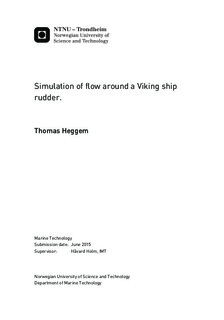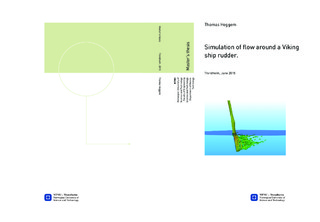| dc.description.abstract | Computational fluid dynamics (CFD) is a numerical method of solving the Navier-Stokes
equations for all points in a grid, or mesh. By performing this operation over multiple
time steps, the resulting velocity and pressure field can be found. This method has been
used to simulate the flow past a Viking ship rudder at different flow regimes.
During sailing with a replica of the Oseberg ship, loss of steering power were experiencedwhen the ship turned to starboard. The reason for this was determined to be the rudder shape. A thicker and longer rudder was made, with the intention to customise the rudder by gradually removing the extra thickness. The rudder had better steering, but not as good as when it turned to port. Moreover, it vibrated at certain angles of attack.
Several CFD analysis has been performed to examine what s causing the loss of lift
and vibrations experienced by the rudder. A mesh of the fluid surrounding the rudder
was generated using an in-house mesh generator developed at NTNU. The rudder was
analysed from angles of attack α=-10 to α=10 degrees, with a 5 degree increase between
simulations. A validation study of NACA0012 airfoil was performed as a part of the
project thesis, and mesh convergence test were performed on the Oseberg rudder mesh.
The angles were tested at rudder rake angles of 20,25 and 30 degrees, at Reynolds number
250, 1000 and 2.4× 10^6 . The latter corresponds to a fully developed turbulent flow, as
such the k- turbulence model was used. For the results the mean drag and lift coefficient, standard deviation and the resulting moments on the free surface was determined. The flow field was then examined through vorticity, characteristics of flow separation and pressure distribution n the surface of the rudder.
At Re=1000/Re=2.4× 106 and α=-10 there was discovered a continuous vortex shedding
on the port side of the rudder. These shed vortices gave rise to a oscillating lift force, and consequently vibrations on the rudder. It was discovered that increasing the rudder rake angle proved advantageous to avoid rapid oscillations of lift, stabilising the lift coefficient as β increased. The mean lift coefficient was higher at α=-10 than at α=10 degrees, indicating that the loss of lift is not caused by vortex shedding and flow separation.
A simplified model of ventilation were calculated to check the risk of air travelling along the rudder from the free surface due to suction pressure. At α=-10 the lowest point where ventilation can occur increase nearly linearly with β, whereas for positive α it is fairly constant. This indicates that the lift for negative angles are generated more by suction pressure than for positive angles. This could cause the lift loss under real conditions.
To avoid vibrations, the rudder need to be more streamlined. Smoothing the leading
edge will cause less flow separation, and increase stability. The rudder is slightly curved inwards at the port side. Making this side straight or with a slight outward curve will also make the rudder more stable against flow separation. | |

